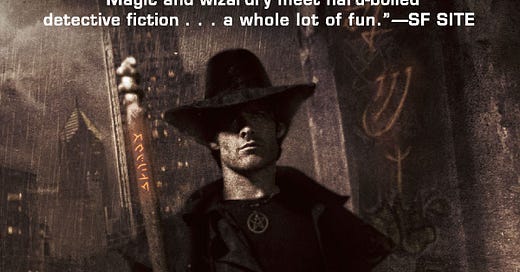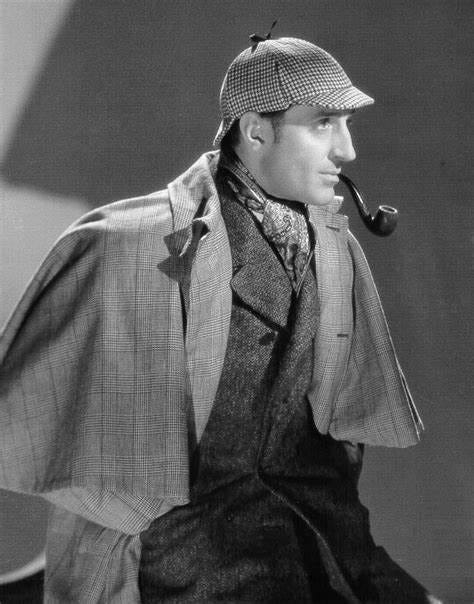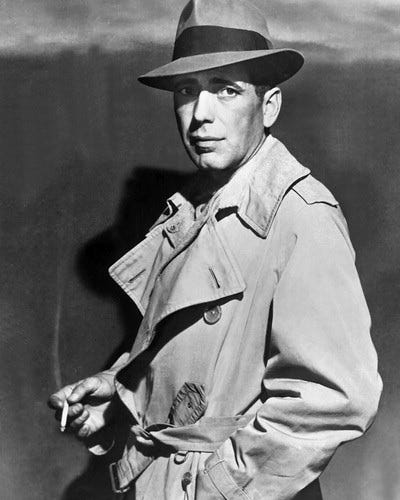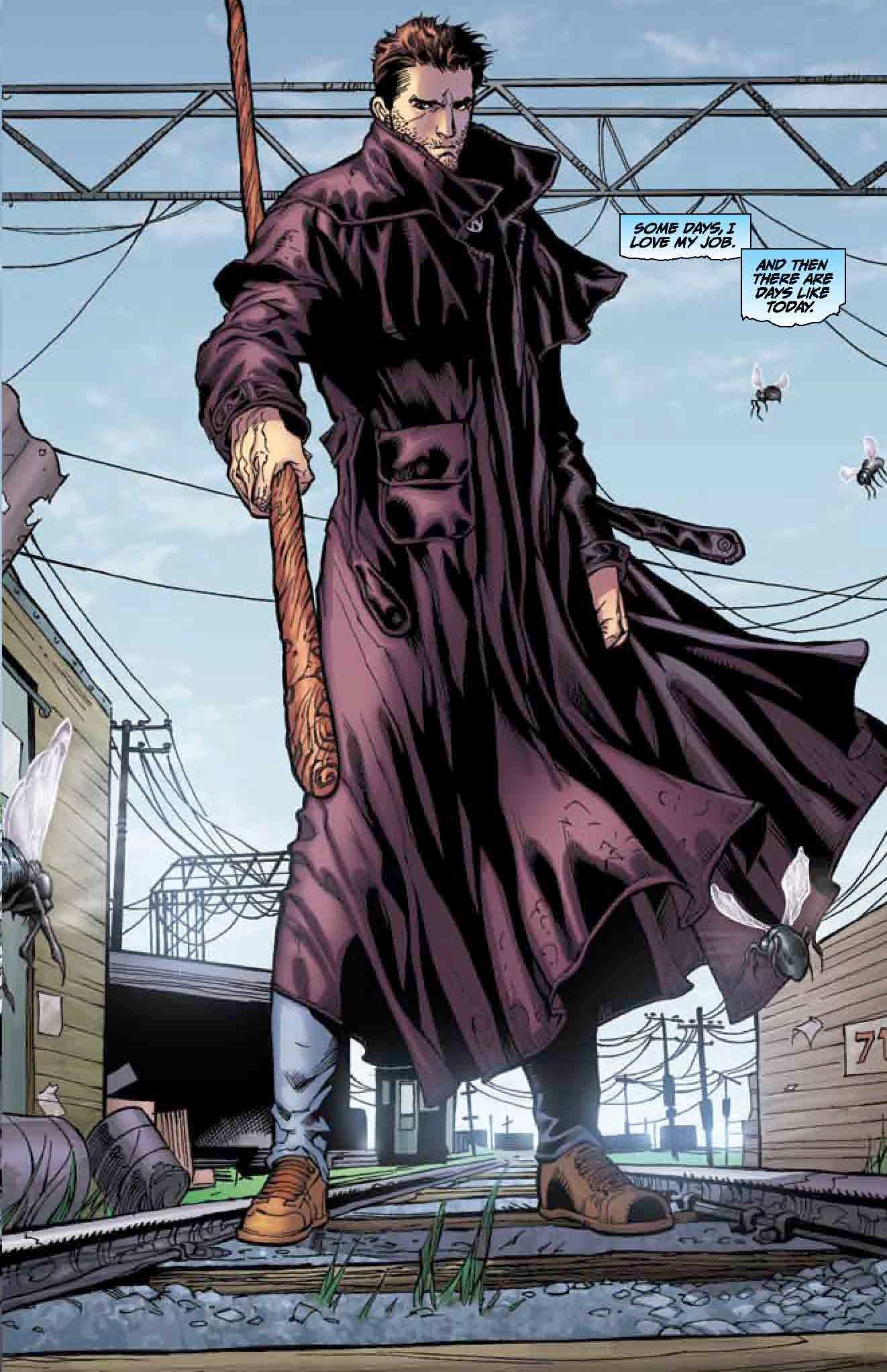Storm Front, by Jim Butcher. Narrated by James Marsters. Buzzy Multimedia, 2009. 8 hours (approx.).
Storm Front by Jim Butcher is best described as a hard-boiled classic occult detective novel. Not surprisingly, it contains tropes of all three subgenres, but it also resists those tropes by giving its protagonist and narrator a snarky, satirical sense of humor. In this essay we will briefly explore the history of the detective genre and its offspring, discuss its tropes using classic detective and occult detective stories as examples, and review how Jim Butcher successfully subverts these tropes to make Strom Front an enjoyable read.
The Classic & Occult Detectives
While elements of the detective story can be traced back as far as Shakespeare, it is widely considered the genre started in 1841 with the publication of Edgar Allen Poe’s “The Murders in the Rue Morgue” in Graham’s Magazine.
C. Auguste Dupin reads about the murders of two women and the arrest of a suspect who happens to be his friend. Convinced his friend is innocent, Dupin investigates the crime scene. His discoveries there lead him to the conclusion: an escaped orangutan killed the victims.
“Rue Morgue” and its two sequels established the conventions of the genre that would go unchanged for decades. In fact, 38 years after Poe’s death, Sir Arthur Conan Doyle’s Sherlock Holmes follows the template to the letter. Both have a personal friend who tells the story: Dr. Watson and an unnamed Englishman vacationing in Paris. The friend can follow but not duplicate the detective’s reasoning, and thus, like the reader, remains baffled to the very end. Neither work for the police and only take cases that especially interest them. Both are eccentric, brilliant and capable of deducing someone’s inner thoughts or building theories on the slimmest of evidence. Watson’s first encounter with Holmes in A Study in Scarlet reads near identical to the opening pages of “Rue Morgue.”
The first occult detectives retained much of what Poe established and differed mainly by adding a supernatural horror element. “Green Tea” (1869) by J. S. LaFanu introduces us to Dr. Martin Hesselius. He is an elderly doctor, independently wealthy and a wanderer. In his wanderings he has garnered much occult knowledge, which he uses to cure peculiar spiritual ailments. Unlike the Dupin/Holmes types, Hesselius is mostly a passive observer, offering commentary on other people’s stories.
In “Green Tea,” the Reverend Jennings complains of hallucinations of a monkey. Later, the monkey talks to him, urging the clergyman to do awful things such as suicide. Hesselius isolates himself until he can concoct a remedy, but he is too late; Jennings slashed his own throat.
The story is told through a series of letters the doctor writes to his German friend. Ostensibly written in the first person, a preface to the story informs us that the letters have been translated and edited by Hesselius’ secretary. This preface creates narrative distance - a gothic method of obscuring the exact nature of the paranormal elements in a story. It also is reminiscent of the personal friend as narrator trope. We do not know the entire extent the secretary has altered the text.
The most famous occult detective is Professor Abraham Van Helsing of Dracula (1897). He plays a more active role than Hesselius, but the similarities are apparent: an elderly doctor with occult knowledge telling the story through correspondence.
There are others. Dr. John Silence, created by Algernon Blackwood for example. But the point has been made and any further examples would be redundant.
The Hard-boiled Detective
In the 1920s, the memory of World War I, the urbanization of American cities, the gang violence associated with Prohibition and the rising crime rates read about in the daily papers may have given rise to a grittier, darker take on the detective story - the hard-boiled detective.
The subgenre’s birthplace was Blask Mask, a pulp magazine. In 1922 Black Mask published Carroll John Daly’s first story, “The False Burton Combs,” and Dashiell Hammett’s first crime story (as Peter Collinson) “The Road Home.” Hammett’s first true hard-boiled story, “Fly Paper,” would be published there in 1929.
The hard-boiled detective story is defined by 1. the sparse writing style, 2. the urban setting, 3. a lone hero in the Western tradition, and 4. an emphasis on the journey rather than the solution.
The first defining feature was typical of the literature of the time. Think of Earnest Hemmingway. As for the second, writers sought to capture a realistic depiction of city life and tell stories that residents of said cities might have read about in the news. Raymond Chandler, a leading hard-boiled writer, said the world he depicted was “not a very fragrant world, but it is the world you live in.”
The detective is often a loner pitted against corruption. He ultimately restores order to the lives of his clients. In this way he shares something with the Western heroes who were also loners and brought order to the wild west. (I am not well versed in Western novels, but for a film example of this see The Magnificent Seven) Finally, the solutions to the mysteries are often contrived, but that isn’t the point. The hard-boiled writer is more interested in keeping the reader guessing what will happen next rather than answering what happened.
Another recurring trope is the femme fatale - a woman who manipluates the detective for her own ends. Often the detective becomes emotionally involved with the case, a drastic difference from Dupin or Holmes’ dispassionate interest.
Storm Front & Beyond
The ponderously named Harry Blackstone Copperfield Dresden is the “only openly practicing professional wizard in the country.” A distraught wife hires him to find her husband. It’s not the sort of case he’d normally take, but work is scarce and the bills are piling up. Meanwhile, Lt. Murphy of Chicago’s Special Investigation Unit (an X-files type division of the PD) asks for Harry’s expertise on an unusual and gory double murder case. Harry suspects there is, indeed, another practicing wizard in Chicago who harnesses magical forces to commit murder.
At its core, Storm Front is a detective story. Harry must beat the pavement, collect the clues, interrogate the suspects to track down the rogue wizard before he becomes the next victim. The quest drags him through the underbelly of Chicago, making enemies of mobsters and vampires along the way. Meanwhile, his friend, Murphy, suspects Harry of the murder – after all, he is the only known wizard capable of the crime.
Harry has more in common with the hard-boiled and occult detectives than the classic one. Although he does occasionally exhibit Dupin brilliance. The story is gritty. It is journey-focused. It incorporates supernatural horror. But what sets Harry apart from Dupin or Sam Spade or Dr. Hesselius is his characteristic humor. Telling his own story rather than relying on a personal friend, Harry is the commentator for the events that happen to him. He often makes snarky remarks that occasionally rise to the level of self-parody.
For example, after a disastrous encounter with a vampire who also heads a brothel, Harry quips, “I'd made the vampire cry. Great. I felt like a real superhero. Harry Dresden, breaker of monsters' hearts.”
And when the character, Morgan, appears for the first time: “Have you ever been approached by a grim-looking man, carrying a naked sword with a blade about ten miles long in his hand, in the middle of the night, beneath the stars on the shores of Lake Michigan? If you have, seek professional help. If you have not, then believe you me, it can scare the bejeezus out of you.”
Besides supernatural horror, Strom Front contains many fantasy elements. Particularly, a magic system. It is well explained without bogging down the story. That alone is a feat not to be overlooked.
Jim Butcher wrote 17 Dresden Files novels since Storm Front debuted in 2000. I have not read all of them, but of the four I have there is a marked decline in quality with each installment. Butcher ramps up the sex, the violence and the foul language. To raise the stakes in each successive book, the stories spiral wildly out of control: from muder and missing person in Storm Front to apocalyptic fairy wars in Summer Knight. A mere private eye becomes the savior of the planet. Harry incrementally takes the shape of a Marvel superhero leaving behind the traditions of the detectives we’ve discussed above.
If you want a real treat, listen to the audiobook. It is narrated by James Marsters who starred in the television series Buffy, the Vampire Slayer. Marsters is an actor, so we might expect him to read well. But his performance in Storm Front (and the others) is truly outstanding. A sigh...a swallow...a shift in his chair...we are in Harry’s basement listening to him tell the story, perhaps over a Scotch.






